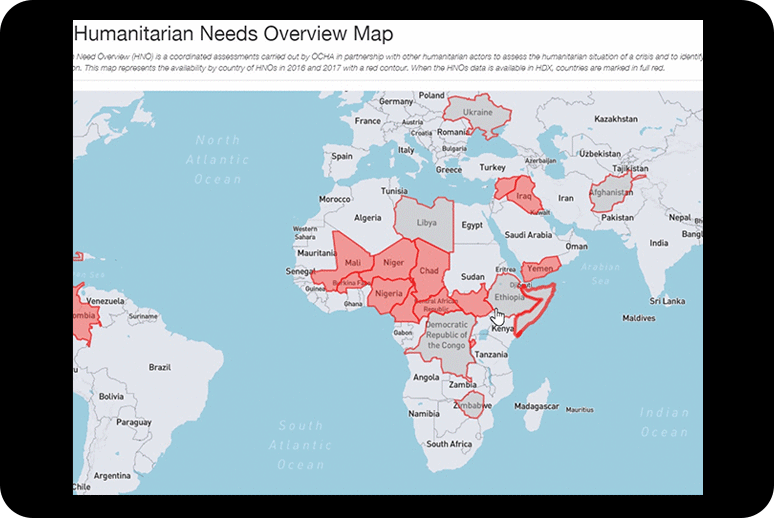Share
The Centre for Humanitarian Data has a new partnership with the Education Above All (EAA) Foundation to improve access to data on education in emergencies. The EAA Foundation through its Protect Education in Insecurity and Conflict (PEIC) programme aims to promote and protect safe access to quality education in challenging environments.
The Centre will be working with EAA and education-focused partners to share data through the Humanitarian Data Exchange (HDX) and to expand the Humanitarian Exchange Language (HXL) to include education-specific tags. Our focus on education data is part of a sector-by-sector approach to bringing all relevant data together to inform humanitarian response efforts.
What data is available?
We started our work by taking a deeper look at the education data that is currently available on HDX. A search for the term ‘education’ results in 374 datasets. A large portion of this data relates to global datasets, covering all countries, from sources like UNDP, UNESCO and UNICEF. Sample indicators include enrollment rates in primary school, completion rates in secondary school, adult literacy rates, and levels of expenditure on education.
We narrowed the focus to 30 countries that have an ongoing humanitarian response or where OCHA has a presence. We then divided the remaining 254 datasets into three categories: school locations, education statistics, and crisis specific. Almost 80 percent of the data falls under education statistics. We provide further details about each category below.
School locations
The location of schools is a critical starting point for understanding education in a given country. The main source of this data in HDX is from the Humanitarian OpenStreetMap Team (HOT) and their ‘points of interest’ dataset. Users can find the data by filtering for features where the ‘amenity’ column contains ‘school’ or ‘university’. However, OSM data cannot be assumed to be complete or authoritative given the openly-editable nature of their mapping system.
Governments are considered an authoritative source for school locations but this data is not often shared openly. One example of such a dataset in HDX is from the Department of Education in the Philippines – it includes 16,022 school locations across the country.
Education statistics
This category of data covers the state of education in a country and represents a baseline from which a crisis would cause a deviation. We have made a distinction between national level data that is represented by a single figure for the country, and sub-national data that is disaggregated below the national level (province, district, facility). Sub-national survey data informs the national figure but this ‘microdata’ is not often shared (although the World Bank has a nice Microdata Library).
Crisis specific
The majority of the crisis data comes from the OCHA who-is-doing-what-where dataset. This data provides an overview of a response and includes data about the work of the Education Cluster or individual organizations focused on education activities. Other interesting data in this category includes satellite-detected damage and destruction of education facilities in the Gaza strip in 2014 from UNOSAT, and the number of people targeted and reached by the Education Cluster (among others) in Somalia, shared by OCHA.
There are no examples of national-level crisis data, but we can imagine a single figure being derived from this data, such as the percentage out of school children due to a crisis.
The dataset that feeds the above visual can be found on HDX here.
Caveats
In doing this review, we did not assess whether the available data is being maintained or how complete the coverage is (beyond the national/sub-national breakdown). We have also not made any indication about the trustworthiness or quality of the data. Data that has been shared privately or is only accessible to users by request is not included.
We did not include a category for funding. OCHA’s Financial Tracking Service includes data about levels of funding for the Education Cluster in various response plans. Financial data about organisations working on education in the development sector is available through the IATI Registry.
What data is missing?
Over the next year and beyond, we want to work with organizations to get more education data shared through HDX. From the visual above, we can see that there is an opportunity to work with Governments to share school location data, either openly or by request in cases where there are security concerns. We are discussing crisis-specific data sharing with UNICEF and Save the Children as the global co-leads for the Education Cluster.
We will work with the EAA and partners such the Global Coalition to Protect Education from Attack on data about attacks on education (facilities, students and teachers) and out of school children. This data is often sensitive and hard to collect but also critical to understanding access to education in conflict environments.
What’s next?
The Centre will host an event with education partners later this year in The Hague (details to come). We have announced our inaugural Data Fellows Programme which has been developed in partnership with the EAA. The Data Science Fellow will have a specific focus on data about education in emergencies, including exploring new approaches to secondary data collection and data storytelling.
Related to the education data visual, we have started research on creating a ‘data grid’ for each country and crisis on HDX. The goal of the grid is to help users understand and communicate what data is available and missing across a set of categories. We welcome ideas on how best to do this and would appreciate feedback on the education data deep-dive that we have provided in this post.
If you would like to learn more or get involved, please contact us at centrehumdata@un.org or via @humdata on Twitter.
